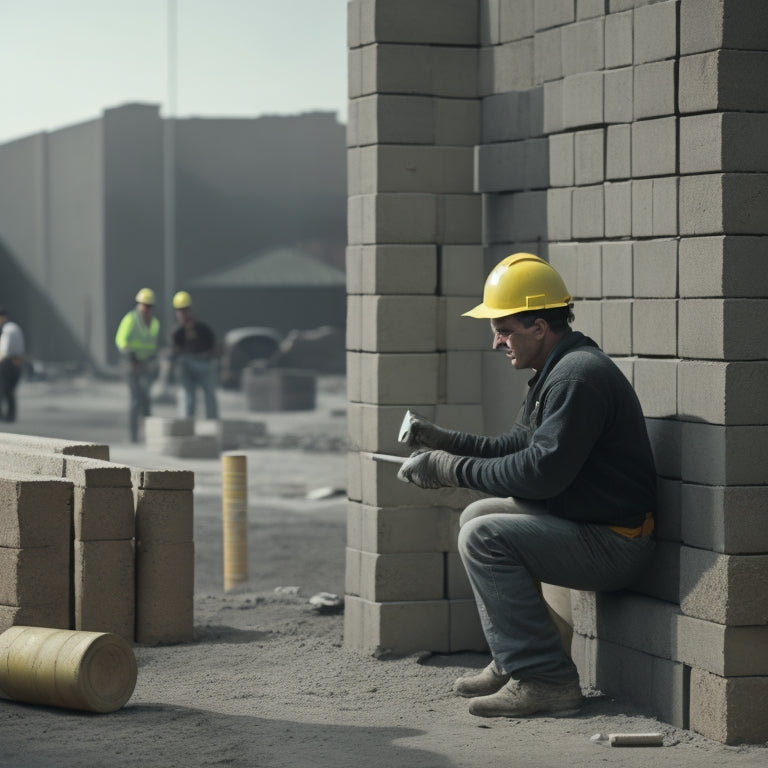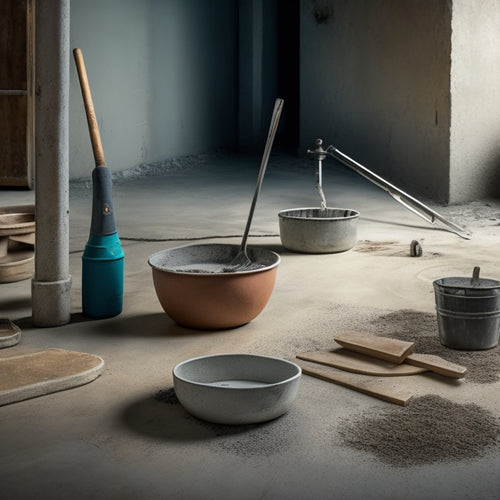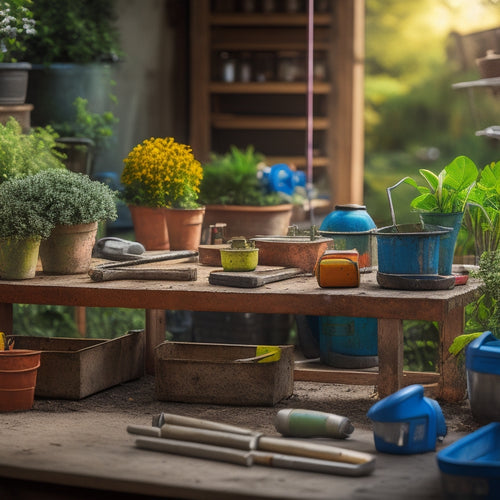
Top 3 Tools for Laying Concrete Blocks
Share
You'll need three essential tools to guarantee a strong and durable concrete block structure: a reliable tamping tool to compact the concrete, such as a plate compactor or hand tamper, depending on the size of your project; a precise leveling tool, like a spirit level or laser level, to ensure even blocks; and a finishing tool, including a mortar mixing paddle, joint smoother, and pointing trowel, to perfect the mortar joints. With these tools, you'll be well on your way to a professional-looking installation. Now, discover the finer details of each tool and how to use them to achieve a flawless finish.
Key Takeaways
• A spirit level is essential for checking block alignment and ensuring an even surface during concrete block laying.
• A mortar mixing paddle ensures uniform mortar consistency, critical for a strong bond between blocks.
• A hand tamper is ideal for smaller, precise tasks and offers control in tight spaces when laying concrete blocks.
• A joint smoother removes excess mortar and smooths joints for a uniform finish, enhancing the overall appearance.
• Regular tool maintenance and storage are crucial to prevent damage and wear, ensuring tools remain effective throughout the project.
Essential Tamping Tool Options
When laying concrete blocks, you'll need to compact the fresh concrete and eliminate air pockets to guarantee a strong, durable bond. This is where vital tamping tool options come into play.
To achieve ideal results, you'll want to master various tamping techniques, including using a plate compactor, hand tamper, or jumping jack compactor. Each tool is designed for specific applications, so it's important to choose the right one for your project. For instance, plate compactors are ideal for large areas, while hand tampers are better suited for smaller, more precise tasks.
Proper tool maintenance is also essential to maintain the longevity of your tamping tools. Regularly clean and inspect your tools to prevent damage and wear. Additionally, store them in a dry, secure location to prevent rust or corrosion.
Block Laying Leveling Essentials
With your freshly laid concrete blocks compacted and air pockets eliminated, you'll need to ascertain they're perfectly level to maintain structural integrity and prevent future issues. This is where leveling techniques come into play.
You'll need a combination of the right tools and a keen eye for detail to ascertain your blocks are aligned properly.
Start by using a spirit level to check the block's alignment. Hold the level against the block's surface, making sure it's centered and even. If the bubble is off-center, adjust the block accordingly. Repeat this process for each block, working your way along the course.
For larger areas or more complex layouts, consider using a laser level. This tool projects a level line or plane, allowing you to quickly identify any deviations from the desired angle.
Mortar and Joint Finishing Tools
Finishing your concrete block installation requires mastering the art of mortar and joint finishing, which involves using specialized tools to achieve a strong, visually appealing bond between blocks.
You'll need to mix mortar to the right consistency, and for that, you'll need a mortar mixing paddle or a mixing drill with a paddle bit. This tool guarantees a uniform mix, which is critical for a strong bond.
Next, you'll need to focus on joint smoothing. A joint smoother or a jointer is essential for this task. This tool helps you remove excess mortar, smooth out the joints, and create a uniform surface. You can choose from various types of joint smoothers, including manual, electric, or pneumatic options, depending on the size of your project and your personal preference.
Additionally, you may also need a pointing trowel for filling and finishing joints. This tool allows you to fill gaps and create a clean, finished look.
Frequently Asked Questions
What Safety Precautions Should I Take When Working With Concrete Blocks?
When working with concrete blocks, you'll want to prioritize safety above all else.
First, make certain you're wearing the right personal protective equipment, including gloves, safety glasses, and a dust mask.
Next, focus on proper lifting techniques to avoid straining your back. Bend at the knees, keep the block close to your body, and lift with your legs, not your back.
Can I Use a Mix of Old and New Concrete Blocks in My Project?
When deciding whether to use a mix of old and new concrete blocks, you'll need to take into account compatibility concerns and aesthetic considerations.
Mixing old and new blocks can lead to inconsistencies in color, texture, and strength, which may compromise the structural integrity of your project.
Additionally, the difference in appearance may be noticeable, affecting the overall visual appeal.
It's crucial to assess the condition and quality of the old blocks before making a decision, ensuring they meet the required standards for your project.
How Do I Prevent Efflorescence on My Concrete Block Walls?
When building your concrete block walls, you'll want to prevent efflorescence, a common issue that can lead to unsightly white stains. To do so, focus on moisture control.
Make sure the blocks are dry before laying, and apply a waterproofing membrane to the foundation. Use a drainage system behind the wall to direct water away, and consider applying a silane-based treatment to the blocks to reduce moisture absorption.
What Is the Recommended Curing Time for Freshly Laid Concrete Blocks?
As you breathe a sigh of relief after laying those concrete blocks, remember that the real work is just beginning.
You're probably wondering, what's the recommended curing time for these freshly laid blocks?
The answer lies in the curing methods you choose. To guarantee proper moisture retention, aim for a minimum of 7 days of consistent misting or 3 days under a waterproof membrane.
This will give your blocks the strength they need to shine.
Can I Use Concrete Blocks for Building a Structure in High-Wind Areas?
When building a structure in high-wind areas, you'll want to guarantee concrete blocks can withstand wind resistance.
Fortunately, you can use them, but it's essential to prioritize structural stability. You'll need to follow design guidelines for wind-load calculations, anchor the blocks securely, and use reinforced materials like rebar.
Additionally, consider using specialized blocks with enhanced wind resistance.
Conclusion
You've made it to the finish line, and your concrete block masterpiece is finally taking shape!
Without these top 3 tools, your project would be a crumbling mess, a DIY disaster zone.
But with them, you're a block-laying ninja, effortlessly constructing walls that'll stand the test of time.
You're a master builder, a concrete conqueror, a champion of structural integrity!
Related Posts
-

7 Must-Have Tools for Concrete Repair Organization
To effectively organize your concrete repair projects, you'll need a thorough toolkit that includes a well-planned st...
-

Why You Need These Concrete Overlay Tools
When tackling a concrete overlay project, you need the right tools to achieve a flawless finish and avoid costly mist...
-

Must-Have Tools for Concrete Planter Projects
As you commence your concrete planter project, you'll need a range of specialized tools to achieve professional-grade...


